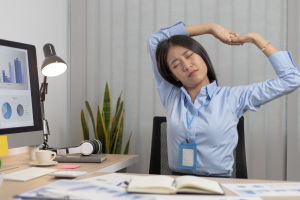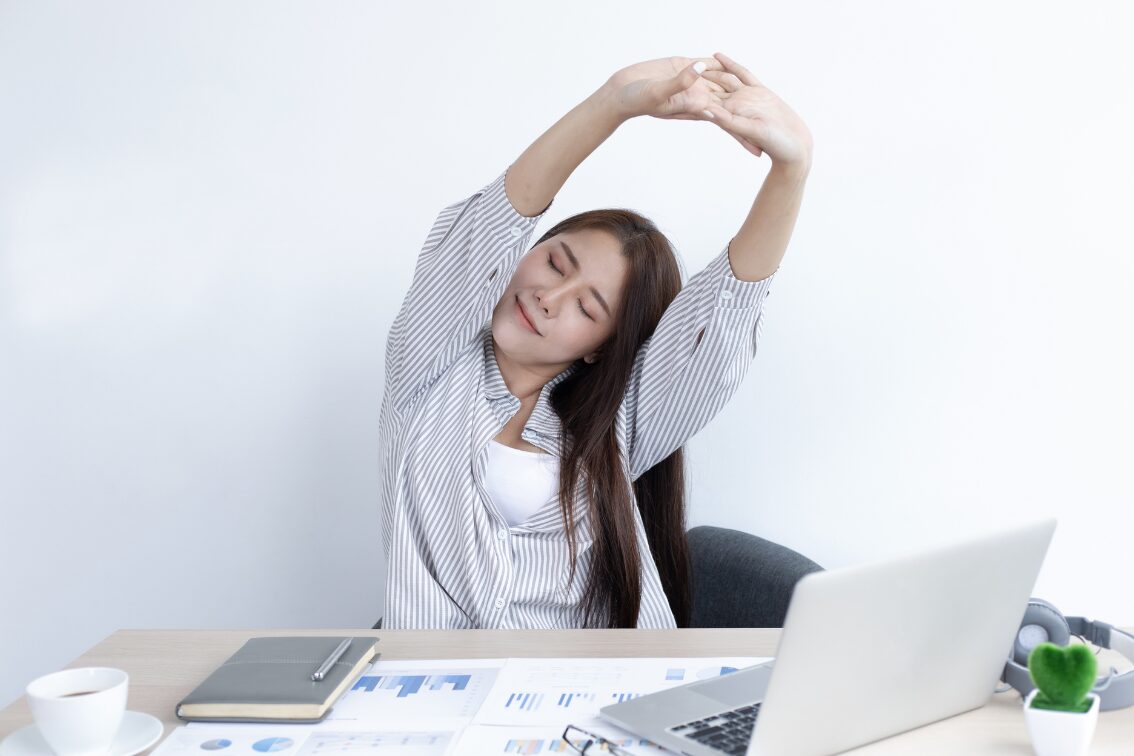*This post may contain affiliate links for which I earn commissions.*
Introduction
If you have arthritis, you know how difficult it can be to stay active without aggravating your joints. Pain, stiffness, and reduced mobility often make traditional workouts feel impossible. But movement is essential for maintaining joint health, and that’s where chair yoga comes in.
Chair yoga is a gentle, low-impact form of exercise that allows you to stretch and strengthen your muscles while sitting or using a chair for support. It’s an excellent option for people with arthritis because it helps reduce stiffness, improve flexibility, and promote relaxation—all without putting unnecessary strain on your joints.
In this article, we’ll explore the best chair yoga exercises for arthritis pain relief, step-by-step instructions for each movement, and tips to ensure you practice safely.
What Is Chair Yoga?
Chair yoga is a modified form of traditional yoga that allows you to perform stretches and poses while seated or using a chair for balance. It’s designed for individuals with limited mobility, making it a perfect choice for those with arthritis, chronic pain, or balance issues.
Unlike floor-based yoga, chair yoga eliminates the need to get up and down from the mat, reducing the risk of strain or injury. Despite being low-impact, chair yoga still provides powerful benefits for flexibility, strength, and overall well-being.
Benefits of Chair Yoga for Arthritis
Chair yoga isn’t just about gentle movement—it has real benefits for those managing arthritis pain. Here’s how it can help:
🔹 Reduces Joint Stiffness and Pain
- Slow, controlled movements help lubricate the joints and ease stiffness.
- Encourages movement without putting too much strain on sensitive areas.
🔹 Improves Flexibility and Range of Motion
- Regular stretching prevents muscles from tightening and joints from locking up.
- Helps increase mobility for daily activities like reaching, bending, and walking.
🔹 Enhances Blood Circulation and Reduces Inflammation
- Movement stimulates blood flow, delivering oxygen and nutrients to the joints.
- Deep breathing techniques help calm the nervous system, which can reduce inflammation.
🔹 Supports Mental Well-being
- Yoga is known to reduce stress and anxiety, which can help manage chronic pain.
- Mindful breathing exercises promote relaxation and mental clarity.
🔹 Improves Balance and Coordination
- Chair yoga can help strengthen stabilizing muscles, reducing the risk of falls.
- Safe, controlled movements build confidence in everyday mobility.
Best Chair Yoga Exercises for Arthritis Pain Relief
You can perform these exercises at home with a sturdy chair and comfortable clothing. Each movement is designed to relieve joint stiffness and improve flexibility.
1. Seated Cat-Cow Stretch 🧘♀️
Benefits: Loosens the spine, improves posture, and relieves back stiffness.
How to do it:
- Sit up straight with your feet flat on the floor and hands resting on your knees.
- Inhale, arch your back, push your chest forward, and look slightly upward (Cow Pose).
- Exhale, round your back, tuck your chin, and pull your belly inward (Cat Pose).
- Repeat for 5–10 breaths.
2. Seated Forward Bend 🌿
Benefits: Gently stretches the lower back, hamstrings, and shoulders.
How to do it:
- Sit near the edge of the chair with your feet hip-width apart.
- Inhale and lengthen your spine.
- Exhale, slowly fold forward, letting your hands rest on your legs or reach toward the floor.
- Hold for 5 breaths, then slowly sit back up.
3. Seated Side Stretch ☀️

Benefits: Improves flexibility in the spine and reduces tension in the waist and ribs.
How to do it:
- Sit tall with your feet flat on the ground.
- Inhale and raise your right arm overhead.
- Exhale and gently lean to the left, feeling a stretch in your side.
- Hold for a few breaths, then switch sides.
4. Seated Spinal Twist 🔄
Benefits: Helps with spinal mobility and reduces stiffness in the back.
How to do it:
- Sit up tall with your feet flat on the floor.
- Place your right hand on the left knee and your left hand on the chair’s backrest.
- Inhale, lengthen your spine, and exhale as you gently twist to the left.
- Hold for 5 breaths, then repeat on the other side.
5. Seated Knee Lifts 🚶♂️
Benefits: Strengthens the lower body and improves circulation in the legs.
How to do it:
- Sit tall with both feet flat on the floor.
- Inhale, lift your right knee toward your chest.
- Exhale, lower it back down.
- Repeat 8–10 times per leg.
6. Wrist and Ankle Rolls 🔄
Benefits: Helps loosen stiff joints in the wrists and ankles.
How to do it:
- Sit comfortably with your feet on the floor.
- Extend your right foot slightly forward and rotate your ankle in slow circles.
- Do the same with your left foot.
- For the wrists, extend your arms forward and gently rotate your hands in circles.
7. Shoulder Rolls 💆♀️
Benefits: Relieves shoulder tension and improves mobility.
How to do it:
- Sit with your hands resting on your thighs.
- Inhale, lift your shoulders up toward your ears.
- Exhale, roll them back and down.
- Repeat 8–10 times.
8. Seated Leg Extensions 🦵
Benefits: Strengthens the quadriceps and helps with knee joint flexibility.
How to do it:
- Sit up tall with your feet flat on the floor.
- Straighten your right leg out in front of you and hold for a few seconds.
- Lower it back down and switch sides.
- Repeat 8–10 times per leg.
9. Deep Breathing Exercise 🌬️
Benefits: Promotes relaxation and reduces stress-related pain.
How to do it:
- Sit with your hands resting on your lap.
- Close your eyes and inhale deeply through your nose.
- Exhale slowly through your mouth.
- Repeat for 5–10 breaths.
10. Relaxation Pose 🧘♂️
Benefits: Allows the body to fully relax and absorb the benefits of your practice.
How to do it:
- Sit comfortably with your hands on your lap.
- Close your eyes and take a few deep breaths.
- Focus on releasing any tension in your shoulders, neck, and jaw, and let your body feel heavy and relaxed.
- Stay in this relaxed position for a minute or two, focusing on your breath.
- When you’re ready, gently open your eyes and bring your awareness back to the present.
Tips for Practicing Chair Yoga Safely

While chair yoga is gentle, it’s still important to practice with care to avoid strain or injury. Here are some key safety tips:
✔ Use a Sturdy Chair – Choose a chair with a firm seat, no wheels, and preferably no armrests to allow for a full range of motion.
✔ Move at Your Own Pace – Never force a stretch; listen to your body and modify movements as needed.
✔ Maintain Good Posture – Keep your back straight and shoulders relaxed throughout the exercises.
✔ Breathe Deeply – Focus on slow, controlled breathing to enhance relaxation and reduce tension.
✔ Avoid Overstretching – If you feel any sharp pain, stop the movement immediately.
How Often Should You Do Chair Yoga for Arthritis Relief?
For best results, aim to practice chair yoga at least 3–5 times per week. Even short sessions of 10–15 minutes can make a noticeable difference in your flexibility, pain levels, and overall well-being. You can also incorporate these movements into your daily routine, especially if you experience stiffness in the morning or after sitting for long periods.
Final Thoughts
Chair yoga is an excellent way to stay active and manage arthritis pain without putting unnecessary strain on your joints. These simple exercises can help improve flexibility, reduce stiffness, and enhance overall mobility—all from the comfort of a chair.
If you’re new to yoga, start slowly and focus on movements that feel good for your body. Over time, you may notice improved strength, balance, and relaxation.
Related Reads
Exercise Guide for Coping with Arthritis: Enhancing Mobility and Reducing Pain
Strengthen and Soothe: Best Exercise Equipment for Arthritis
Give these chair yoga exercises a try, and let me know in the comments which one helps you the most! 🌿🧘♀️




